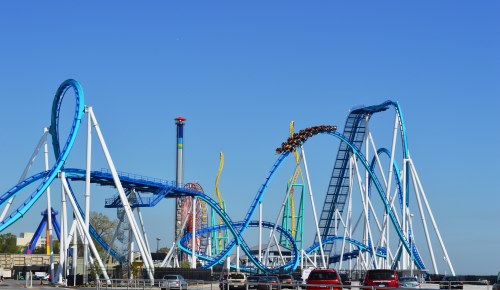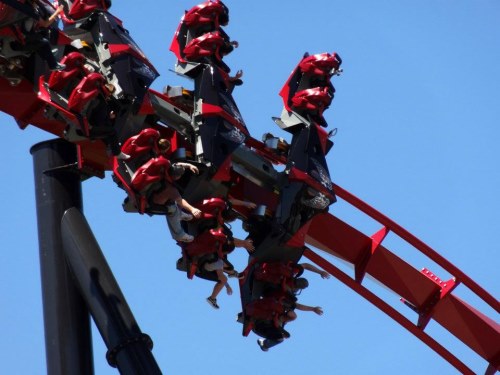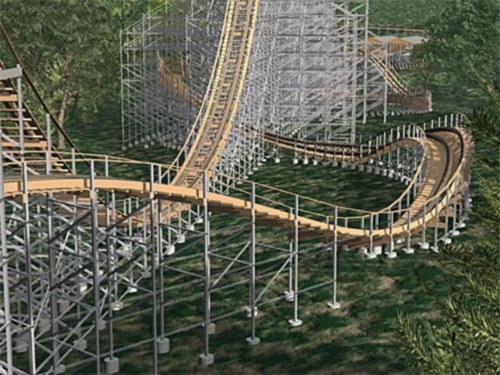Summer is approaching. For some it means beaches and pools and for others, it means heading out to a local theme park and enjoying the thrill of a roller coaster.

The Gatekeeper, Sandusky, OH. (Image via Nick Weisenberger)
Ever wonder what it takes to build a behemoth attraction like this? Although a very competitive profession, roller coaster engineers are the people dedicated to creating and re-inventing your park rides.
In order to design a roller coaster, these engineers use the same CAD software as any other engineers, but often they must combine in-house and commercial software. To draft and adjust designs, roller coaster engineers can use AutoCAD and programs such as CATTA, SolidWorks, and Auto Desk Inventor to help them keep all of their designs in just one computer program.
The most important aspect of roller coaster design is safe fun. (Who wants to ride a boring roller coaster?)
“A roller coaster designer's main objective should always be to produce as many safe accelerations, or g-forces, for the rider as possible,” said Nick Weisenberger, mechanical engineer and author of Coasters 101: An Engineer’s Guide to Roller Coaster Design.
In order to create a good design, the engineer must manage the drag and other resistant forces to make sure riders are having fun from the moment they take off to the moment they smoothly return back to the station.
Engineer power and funding
Every roller coaster has different needs. Some roller coasters can be designed by just four engineers (of course assembly, testing, and marketing require much more man-power) and can take between one and five years total construction time. And it’s not cheap.
“Today, a large steel coaster averages about $20 million, while a wooden coaster will only set you back a cool $10 million, theming not included,” said Weisenberger.
In order to keep roller coasters from becoming stale, engineers are always looking for new and exciting variations. One new breed of roller coasters being built is called the “wing” or “4D” coaster.

A “wing” coaster. (Image via Nick Weisenberger)
“Wing coasters feature seats cantilevered off the side of the train instead of being on top of or below the rails allowing passenger’s feet to dangle freely,” said Weisenberger.
Engineers are also turning to different kinds of pre-fabricated tracks for wooden coasters that are made perfectly in a shop and then shipped to the site. Creating the tracks off-site helps provide a much smoother ride. Incorporating more components in wooden coasters, they actually perform like a steel coaster, but with more intense moves and at a lower cost.
Challenges
It’s not all fun and design engineering a roller coaster. A big challenge is to keep discovering new and unique ways to keep riders thrilled and safe by designing new restraint systems.
Some roller coaster picks
Cedar Point in Sandusky, OH, has just introduced the “Gatekeeper” (pictured above), a 102-piece winged roller coaster that allows riders to dangle 170 ft above the beach before undergoing a 180-degree turn and plummeting to just 6 ft above ground.
“If I have to pick one, I’ll say The Voyage at Holiday World (Santa Claus, IN). My favorite sensation on a roller coaster is airtime, when you go over a hill, lift off your seat, and experience negative gravity, and the Voyage delivers more airtime than any other coaster I’ve ridden,” said Weisenberger.

The Voyage at Holiday World, Santa Claus, OH.
Roller coaster technology impact
The technology used in your typical roller coaster ride has begun to spur other innovations. GE, well-known appliance and power company, created an electric linear motor system for a Six Flags Magic Mountain theme park ride in California that catapults a 415-ft-tall roller coaster at 100 miles per hour. Now, that technology has inspired an electric catapult that could fling fighter jets weighing as much as 37 tons.
I guess roller coasters are more than just a two minute thrill.
What kind of roller coaster would you design? Have a favorite? Tell us below.
Nick Weisenberger is a member of the ASTM International Committee that creates and maintains the safety standards for amusement rides and devices and is the co-manager of Coaster 101.com. He graduated from the University of Toledo with a degree in mechanical engineering and has since participated in roller coaster projects that involve 3D modeling, kinematic simulations, and maintenance planning efficiency.
Advertisement
Learn more about Electronic Products Magazine





